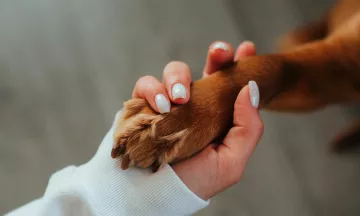For many of us, our pets are (quite rightly) part of the family. This means that we’re faced with a difficult dilemma in the event of a separation or divorce. Putting your pet’s interests first and knowing what to do in such a situation requires being adequately informed. So how can you ensure that your pet doesn’t suffer from an impending separation or divorce?
In the majority of relationships, there’s no clear-cut ‘owner’ of the cat or dog. Perhaps you embarked upon the relationship with an existing pet, which has now become an inextricable part of your partner’s life. Or, conversely, you’ve become irrevocably attached to your partner's dog. Alternatively, you may have chosen your pet together. Nevertheless, in the event of a divorce or separation, you must decide with whom the pet is going to reside. In some cases, a judge is involved in assigning the animal to one of the two partners. Fortunately, the judge will always consider the welfare of the pet in this type of situation.
Access agreements for pets
In the eyes of the law, your pet is an object. It is, therefore 'allocated' in the same way as a sofa or table in a custody dispute. Indeed, there are no regulations pertaining to access as there are for children. Nonetheless, many couples make clear agreements (potentially with the help of a mediator) about where the pet will reside and when, as well as the costs associated with pet care, vet bills, food, pet sitting services etc. During a happy marriage or partnership, it can be tempting to push such unpleasantries to the back of your mind. However, it’s a good idea to document the various scenarios and their corresponding solutions on paper, in case of emergencies. That way your beloved pet will be assured of the proper care and stability it deserves, and you’ll know exactly what your responsibilities are in the event of a break-up. Consider the following:
- Who originally purchased/acquired the pet?
- With which partner does the pet have the strongest bond?
- Which partner can devote the most time to caring for the pet?
- Which partner has the greatest financial resources at their disposal?
It’s essential to put the welfare of your pet first. A divorce can be somewhat messy and emotional. But don’t forget that changes to the family unit are also a major source of stress for your pet. Many pets are extremely sensitive to tension, so it’s important to remain calm both during and after the separation.
When you’re together as a family, there’s generally someone at home who can take care of the pet. If you end up alone and work during the day, then there’s often little time left for your cat or dog. A dog sitter can help you out during the day when you as a single 'dog parent' are at work. Also, many ex-couples align the care of their pet to the same arrangements made for the children. That way your pet still receives sufficient attention and the kids needn’t pine for their four-legged friend.

Access agreement pitfalls
Whilst some dogs love living in two households, co-parenting isn’t usually a pleasant experience for your canine companion. Indeed, switching between two worlds can be extremely confusing. So, try to stay on good terms with your ex-partner and make sure that you carefully coordinate the dog's upbringing, rules and daily routine. A new home environment can be uncomfortable for your dog, particularly if a new partner is present. A dog may also be more attached to one of the two separating partners. A dog who misses their 'favourite' owner may become depressed, which can manifest in excessive licking/scratching, peeing or pooing in the home, loss of appetite and other problem behaviours.
Help your dog through this difficult period. Don’t punish them if they exhibit 'naughty', disobedient or stressed behaviour. Instead, give them the time they need. After all, your dog is simply having a normal reaction to an abnormal situation. Make sure that drop-off and collection times are calm and argument-free and give your dog plenty of reassurance. Allow your dog to gradually adjust to their new life by ensuring that the new home contains familiar elements, such as their own basket and cuddly toys. And give your dog additional attention by going for long walks and showering with affection. Read more about how to be affectionate with your dog.
The ideal solution?
Cats are typically more attached to their surroundings than people, thus access arrangements tend not to be an option. A change of home will cause your cat a significant amount of stress. They may start marking their territory, try to escape or even run away. The best solution for both cats and also for many dogs (and one that’s increasingly common for children), is for the pet to remain in the original 'parental' home, whilst the separating partners take it in turns to stay there. This creates a stable home environment for all concerned.
Relationship breakdowns are painful enough as it is. A satisfactory solution is thus not only important for your pet; but also for you personally: the bond that you have with your cat or dog can provide an enormous amount of support during difficult periods. So, be proactive in preventing problems and talk things through with your partner: what arrangements should you put in place, for both now and in the future? What’s best for your pet? Don’t forget to periodically evaluate these agreements, as situations and opinions can change over the course of time: one partner may become more attached to the pet, for example.
We’re curious about your experiences. Who ‘owns’ the pets in your relationship? Have you made any agreements about what to do in the event of a break-up? Are you currently co-parenting a pet? You can leave your comments below or on our Facebook page.





